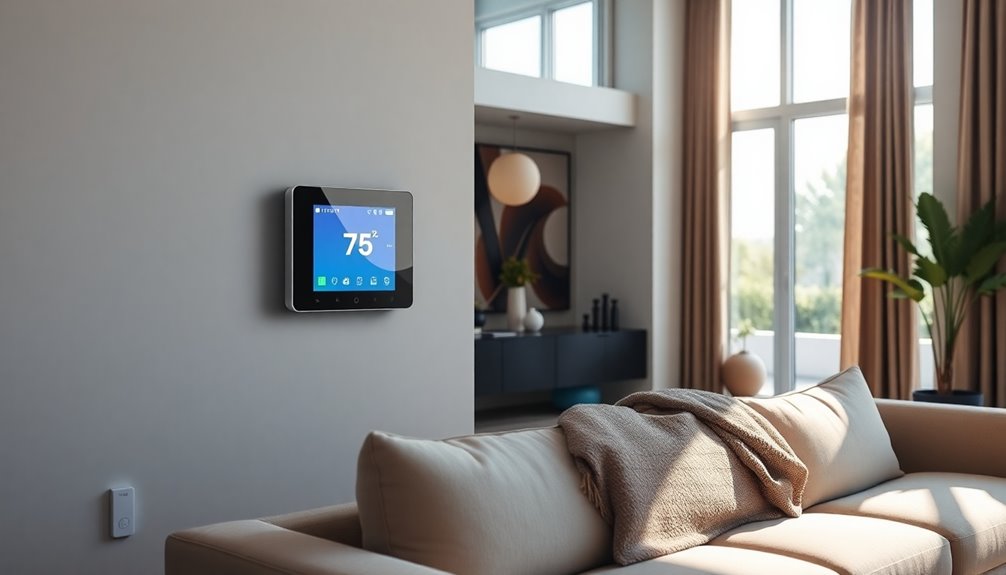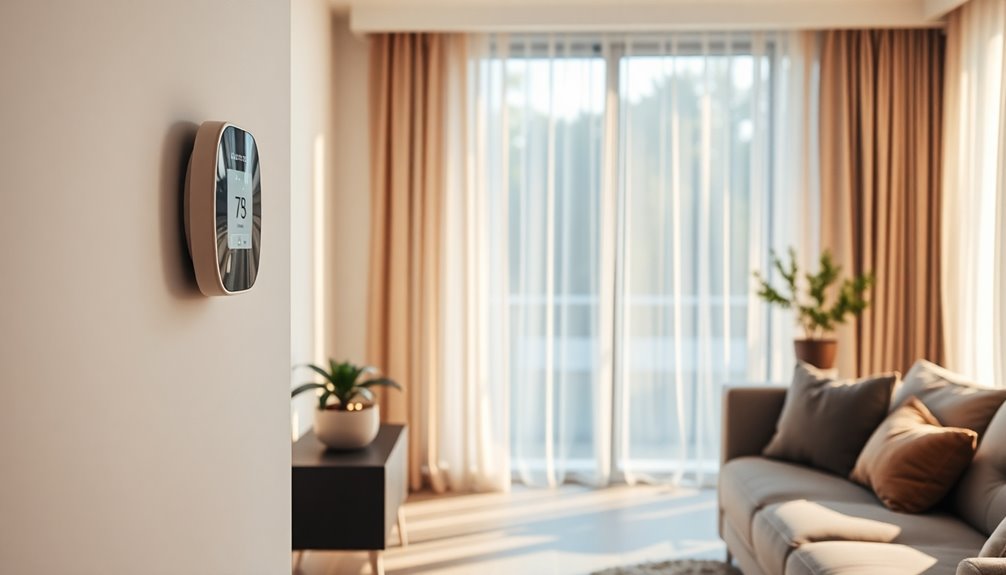If you're looking to optimize your home's comfort, I've found some of the best smart thermostats with remote sensors. Models like the Honeywell Home T9 and ecobee Smart Thermostat Premium stand out for their energy efficiency and user-friendly features. These devices adapt to your lifestyle and allow for precise temperature control. You'll also discover how to choose the right thermostat to suit your specific needs as you explore further.
Key Takeaways
- Look for smart thermostats with Energy Star certification to maximize energy savings and reduce heating and cooling costs by up to 26% annually.
- Ensure compatibility with your existing HVAC system to avoid installation issues and ensure optimal performance across different setups.
- Choose models featuring remote sensors for precise temperature control in multiple rooms, enhancing overall comfort throughout your home.
- Consider user-friendly apps that enable easy remote access and control, allowing adjustments from anywhere for convenience and efficiency.
- Evaluate features like adaptive scheduling and geofencing to automatically optimize temperature settings based on your lifestyle and location.
Honeywell Home T9 WiFi Smart Thermostat with Smart Room Sensor
If you're looking for a smart thermostat that adapts to your lifestyle and keeps your home comfortable, the Honeywell Home T9 WiFi Smart Thermostat with Smart Room Sensor is a fantastic choice. This sleek thermostat, weighing just 1.32 pounds, features a user-friendly touchscreen display. Its Smart Room Sensors can detect occupancy and adjust temperatures automatically, ensuring every room feels just right. I love that I can control it remotely via my phone, making energy savings effortless. Plus, it's compatible with major smart home systems like Amazon Alexa and Google Assistant, adding to its convenience. Overall, it's a smart investment for any home.
Best For: Homeowners looking for a smart thermostat that enhances comfort and energy efficiency through remote control and automated temperature adjustments.
Pros:
- User-friendly touchscreen display makes it easy to navigate settings and schedules.
- Smart Room Sensors allow for customized temperature control based on occupancy, ensuring comfort in every room.
- Remote access via mobile app enables convenient adjustments from anywhere, contributing to energy savings.
Cons:
- Some users have reported a lack of adjustable differential settings, which may limit temperature customization.
- Installation may require a power adapter for homes without a C-wire, which could complicate setup for some users.
- Not compatible with electric baseboard heat, limiting its use in certain homes.
ecobee Smart Thermostat Premium with Smart Sensor
The ecobee Smart Thermostat Premium with Smart Sensor is perfect for homeowners who want to enhance their indoor comfort while saving on energy costs. With its ENERGY STAR certification, I've noticed up to 26% savings on my heating and cooling bills. The included SmartSensor eliminates hot and cold spots, making my home feel consistently comfortable. I love the built-in air quality monitor that keeps me informed about my indoor environment. Plus, it integrates seamlessly with Siri, Alexa, and Google Assistant, allowing for easy voice control. Overall, I recommend this thermostat for anyone looking to optimize their home's comfort.
Best For: Homeowners seeking to enhance indoor comfort and save on energy costs through smart technology.
Pros:
- ENERGY STAR certified, leading to potential savings of up to 26% on heating and cooling expenses.
- SmartSensor included, effectively eliminates hot and cold spots for consistent comfort throughout the home.
- Built-in air quality monitor provides real-time updates on indoor air quality and maintenance reminders.
Cons:
- Some users experienced challenges with installation and sensor pairing, potentially requiring professional assistance.
- Mixed reviews on customer support experiences, with some users finding it less helpful during installation issues.
- Additional sensors may be recommended for optimal performance in frequently used rooms, which can lead to extra costs.
Google Nest Learning Thermostat (4th Gen, 2024) with Temperature Sensor
For anyone seeking a blend of advanced technology and user-friendly design, the Google Nest Learning Thermostat (4th Gen, 2024) with Temperature Sensor stands out. Its sleek, polished finish and larger display make it a stylish addition to any home. I love how it learns my preferences, automatically adjusting temperatures for maximum comfort. The Nest Temperature Sensor guarantees precise control in different rooms, which is a game changer. Plus, I appreciate the energy savings—up to 15% on cooling bills! With easy installation and compatibility with most systems, it's a smart investment for anyone looking to enhance their home's efficiency and comfort.
Best For: Individuals and families seeking a stylish, energy-efficient thermostat that learns their preferences for optimal comfort and savings.
Pros:
- User-friendly installation with compatibility for most 24V systems and no C wire needed for most homes.
- Energy savings of up to 15% on cooling bills and 12% on heating bills, leading to noticeable reductions in utility costs.
- Smart features like Adaptive Eco mode and room-specific control with the Nest Temperature Sensor enhance comfort and convenience.
Cons:
- Higher price point compared to traditional thermostats, which may deter budget-conscious consumers.
- Some users may need additional screws for installation, which can complicate the setup process.
- Dependence on Wi-Fi for full functionality, which may be an issue in areas with unstable internet connections.
ecobee Smart Sensor 2 Pack for Smart Home
With its impressive occupancy detection feature, the ecobee Smart Sensor 2 Pack is an ideal choice for homeowners seeking to enhance comfort and energy efficiency. I love how it communicates temperature from up to 60 feet away, even through walls. This means my home stays cozy, no matter where I am. The energy savings are fantastic, too; it reduces heating and cooling in unoccupied spaces. Plus, the real-time alerts keep me informed of any unexpected movement. Installation is a breeze, and with a battery life of five years, I don't have to worry about constant replacements. It's a must-have for smart homes!
Best For: Homeowners looking to improve comfort and energy efficiency in their smart homes.
Pros:
- Easy installation with flexible mounting options (magnetic or adhesive).
- Long battery life of up to 5 years, minimizing maintenance.
- Effective occupancy detection enhances temperature control and energy savings.
Cons:
- Some users may find the pricing relative to functionality a concern.
- Requires ecobee Smart Thermostats for full compatibility.
- Real-time alerts require a subscription to Smart Security for functionality.
Sensi Touch 2 Smart Thermostat (ST76)
Looking to enhance your home's comfort while saving on energy costs? The Sensi Touch 2 Smart Thermostat (ST76) might be your answer. With its touchscreen color display and Wi-Fi capabilities, it's easy to manage from anywhere. I love its Energy Star certification, which helps me save around 23% on HVAC energy. Installation is a breeze with the app guiding me, though I needed a C-wire. Adding remote sensors greatly improved my home's temperature uniformity. Plus, the app's intuitive design makes programming a snap. Overall, I highly recommend this thermostat for its value, functionality, and impressive comfort enhancements.
Best For: Homeowners looking for an easy-to-use smart thermostat that enhances comfort and reduces energy costs.
Pros:
- Energy savings of approximately 23% on HVAC energy through programmable features and remote access.
- Intuitive app design allows for quick and easy programming and adjustments.
- Compatible with remote sensors for improved temperature uniformity throughout the home.
Cons:
- Requires a common wire (c-wire) for installation, which may not be available in all homes.
- Some users reported Wi-Fi connection issues during setup.
- The setup process includes a security pin that changes with each failed attempt, which can be frustrating.
LEVOIT Smart Thermostat for Home (Aura 400S)
The LEVOIT Smart Thermostat for Home (Aura 400S) stands out as an ideal choice for homeowners seeking energy efficiency and advanced control. I love how customizable routines help conserve energy when I'm away, plus I get daily energy reports. With the option to connect up to 16 sensors, I can monitor temperatures room-to-room. The 4-inch touchscreen is sleek, although the font size for other text could be larger. While installation can be straightforward, I recommend checking compatibility with your HVAC system first. Overall, I find it visually appealing and functional, enhancing comfort throughout my home.
Best For: Homeowners looking for energy-efficient solutions and advanced temperature control features in their living spaces.
Pros:
- Customizable energy-saving routines and daily energy reports enhance efficiency.
- Ability to connect up to 16 sensors for comprehensive temperature monitoring throughout the home.
- Visually appealing design with a high-resolution touchscreen for easy control.
Cons:
- Installation may vary in difficulty depending on HVAC compatibility, requiring careful checks beforehand.
- Some users report small font sizes on the display, making it hard to read non-temperature information.
- App connectivity issues, such as device timeouts, can hinder user experience.
Sensi Room Sensor-Compatible with Sensi Touch 2 Smart Thermostat
If you're seeking a way to enhance comfort in specific areas of your home, the Sensi Room Sensor, designed for the Sensi Touch 2 Smart Thermostat, is an excellent choice. This battery-powered sensor monitors temperatures and humidity, ensuring comfort where you need it most. Its flexible design allows for easy placement, whether mounted on a wall or positioned on a stand. With a user-friendly app, I can adjust settings effortlessly. Plus, its ability to reduce hot and cold spots makes it perfect for large spaces. With a solid warranty and positive reviews, it's a smart addition to my home.
Best For: Homeowners seeking to improve temperature control and comfort in specific areas of their home.
Pros:
- User-friendly app allows for easy monitoring and adjustments from anywhere.
- Flexible placement options make it simple to position the sensor where needed, either on a stand or mounted on a wall.
- Energy efficiency is enhanced by targeted temperature control, potentially reducing energy costs.
Cons:
- Requires battery replacement for continuous operation, which may be inconvenient.
- Limited compatibility as it only works with Sensi Touch 2 Smart Thermostat.
- Dependent on Wi-Fi and Bluetooth for connectivity, which may be an issue in areas with weak signals.
GE Cync Smart Thermostat and Temperature Sensor Bundle
For anyone seeking an energy-efficient solution that offers seamless integration with smart home systems, the GE Cync Smart Thermostat and Temperature Sensor Bundle stands out. This Energy Star Certified thermostat allows me to program custom schedules through the user-friendly Cync app, compatible with Amazon Alexa and Google Home. I love how I can add sensors to different rooms, optimizing temperature control and minimizing those annoying hot and cold spots. While installation is straightforward, I recommend checking the Cync website for wiring diagrams. Overall, it's a great choice if you want smart control and comfort in your home.
Best For: Those looking for an energy-efficient smart thermostat that easily integrates with existing smart home systems.
Pros:
- User-friendly app allows for easy scheduling and customization of temperature settings.
- Energy Star Certified, promoting energy efficiency and cost savings.
- Ability to add smart sensors to different rooms for optimized temperature control, reducing hot and cold spots.
Cons:
- Limited to a 4-degree temperature range and only compatible with 2.4GHz WiFi, excluding 5GHz networks.
- Reports of defective units and varying customer service experiences may lead to installation challenges.
- Some users experienced difficulties with WiFi setup and app usage, highlighting potential software limitations.
Smart Programmable Thermostat with Smart Sensor
Looking for a way to maintain ideal comfort in every corner of your home? The Smart Programmable Thermostat with Smart Sensor might be just what you need. With 7-day scheduling and compatibility with over 95% of HVAC systems, it's designed for efficiency. I love that it can save up to 26% on heating and cooling costs! The large 3.95-inch screen makes it easy to check settings, though I've noticed some users find the interface tricky. Plus, the remote control feature is a game-changer. Just be mindful of potential temperature accuracy issues—it can be a bit off at times.
Best For: Homeowners looking for an efficient and programmable solution to manage their heating and cooling costs while enjoying remote control features.
Pros:
- Energy Savings: Can save up to 26% annually on heating and cooling costs compared to a constant 72°F setting.
- Compatibility: Works with over 95% of 24VAC HVAC systems, making it versatile for various home setups.
- User-Friendly Features: Offers 7-day scheduling and remote control via an app for convenient temperature management.
Cons:
- Temperature Accuracy: Reports indicate the thermostat can be 2-4 degrees off from actual readings.
- Interface Issues: Some users find the interface non-intuitive and button icons unclear, leading to delayed responses.
- Reliability Concerns: Mixed feedback regarding malfunctioning heating systems and settings being overridden.
Honeywell Home Smart Room Sensor (RCHTSENSOR-1PK)
The Honeywell Home Smart Room Sensor (RCHTSENSOR-1PK) is perfect for anyone seeking personalized comfort in their living spaces, especially if you have a busy household. This sensor seamlessly integrates with Honeywell T9 and T10 thermostats, allowing me to monitor temperature and humidity in multiple rooms. I love how it prioritizes occupied spaces, ensuring comfort as my family moves around. The DIY installation is a breeze, and I appreciate the app connectivity with Alexa and Google Assistant. With an impressive 4.6-star rating, it's clear that others share my satisfaction in improved temperature management and reduced bills.
Best For: Families looking for customizable temperature and humidity control in their home for enhanced comfort and energy savings.
Pros:
- Easy DIY installation without the need for tools.
- Integrates seamlessly with smart home systems like Alexa and Google Assistant.
- Prioritizes comfort in occupied rooms, improving overall temperature management.
Cons:
- Some users find the app navigation unintuitive.
- Occasional inaccuracies in temperature readings reported by users.
- Requires two AAA batteries, which may need to be replaced periodically.
Google Nest Temperature Sensor for Smart Home
Smart thermostats with remote sensors, like the Google Nest Temperature Sensor, are perfect for anyone who desires precise climate control in specific rooms of their home. I love how it seamlessly integrates with my Nest Learning Thermostat, allowing me to monitor temperatures in places like the living room and baby's room. Installation was a breeze, and I appreciate the wireless setup and the two-year battery life. The Nest app lets me prioritize rooms and adjust settings remotely, ensuring ideal comfort. While some users report occasional disconnects, I've found it enhances my home's energy efficiency and overall comfort remarkably.
Best For: Anyone looking for enhanced climate control in specific areas of their home with a smart home ecosystem.
Pros:
- Seamless integration with compatible Nest thermostats for personalized climate control.
- Easy installation and wireless setup with a long battery life of up to 2 years.
- Remote access via the Nest app allows for convenient temperature adjustments and room prioritization.
Cons:
- Some users report compatibility issues in certain regions, like the UK.
- Occasional disconnects have been noted by users affecting performance.
- Importance of ensuring the correct version of the Nest thermostat before purchasing to avoid issues.
Honeywell Home T9 WIFI Smart Thermostat
For those who value both comfort and energy efficiency, the Honeywell Home T9 WIFI Smart Thermostat stands out with its Smart Room Sensor capability. I love how its adaptive scheduling aligns with my family's lifestyle, helping save on energy bills. The touchscreen display works seamlessly with Alexa and Google Assistant, making control effortless. Plus, the optional Smart Room Sensors allow me to focus on temperature control in multiple rooms. I appreciate the easy setup and the Resideo app, which gives me intuitive programming options. While it may lack some features of pricier models, its affordability makes it a solid choice for any home.
Best For: Families looking for an affordable smart thermostat that prioritizes comfort and energy efficiency with easy-to-use features.
Pros:
- Adaptive scheduling that aligns with user lifestyle for enhanced energy savings.
- Touchscreen display compatible with Alexa and Google Assistant for effortless control.
- Optional Smart Room Sensors for precise temperature control in multiple rooms.
Cons:
- Lacks advanced features like accessory control (e.g., humidifiers) compared to pricier models.
- Geofencing functionality is less advanced than occupancy detection available in competitors.
- Design is functional but may appear less modern than some alternatives on the market.
MoesGo Programmable WiFi Smart Thermostat for Home
Looking to enhance your home's energy efficiency? The MoesGo Programmable WiFi Smart Thermostat is a solid choice! It seamlessly integrates with your system, provided you have the C-wire adapter. I love its 7-day programmable schedule and remote control feature, allowing me to adjust temperatures from anywhere via my smartphone. Plus, it comes with a free temperature sensor for better monitoring. While some users report setup challenges, the energy savings of over 23% make it worthwhile. Just keep in mind it requires a 2.4GHz WiFi connection. Overall, it's a practical addition to any smart home!
Best For: Homeowners looking for an energy-efficient and remotely controllable thermostat with programmable features.
Pros:
- Energy Savings: Reduces energy consumption by over 23%, helping lower utility bills.
- Remote Control: Allows temperature adjustments from anywhere using a smartphone app.
- Programmable Schedule: Offers a 7-day customizable schedule for temperature control.
Cons:
- Setup Challenges: Some users find the installation instructions lacking and difficult to follow.
- Connectivity Issues: Occasional problems reported with the temperature sensor's connectivity.
- Compatibility Limitations: Requires a C-wire adapter and is not compatible with heating-only systems or high voltage.
Smart Thermostat with Smart Sensor and WiFi Compatibility
A standout feature of the Smart Thermostat with Smart Sensor and WiFi compatibility is its ability to connect seamlessly with 90% of home heating and cooling systems. I love how it reduces heating and cooling costs by over 25% annually, and I can monitor energy savings through the Smart Life App. With the ability to control it remotely via Wi-Fi and voice commands using Alexa or Google Assistant, I can adjust temperatures from anywhere. The easy installation is a plus, though I found the schedule setup a bit tricky. Overall, it's an attractive and functional addition to my smart home.
Best For: Homeowners looking for an energy-efficient smart thermostat that offers remote control and compatibility with a wide range of HVAC systems.
Pros:
- Reduces heating and cooling costs by over 25% annually, promoting energy efficiency.
- Compatible with 90% of home systems and supports voice control via Alexa and Google Assistant.
- Easy installation with an attractive design and responsive touch screen.
Cons:
- Some users may find the software confusing when setting schedules.
- Requires a common wire (C-Wire) for installation, which may be a limitation for older systems.
- Mirrored screen can make visibility challenging in certain lighting conditions.
Google Nest Temperature Sensor (2nd Gen) 3 Pack
Managing temperature discrepancies in your home can be a challenge, but the Google Nest Temperature Sensor (2nd Gen) 3 Pack is designed to tackle just that. With simple setup through the Google Home or Nest app, I can easily schedule specific temperatures for different rooms. These sensors boast a three-year battery life, so I don't have to worry about constant maintenance. Their sleek design fits seamlessly into any room, and they work perfectly with the Nest Learning Thermostat. Overall, they enhance comfort by balancing temperatures effectively, especially in those stubbornly hot or cold spots.
Best For: Homeowners looking to manage temperature variations and enhance comfort in specific rooms.
Pros:
- Easy installation and setup through the Google Home or Nest app.
- Long battery life lasting up to 3 years, minimizing maintenance efforts.
- Sleek design that blends seamlessly into any room decor.
Cons:
- Difficulty in averaging temperatures across multiple sensors may require manual adjustments.
- Account linking limitations can be frustrating for some users.
- Cost of multiple sensors might be a concern for budget-conscious consumers.
Factors to Consider When Choosing a Smart Thermostat With Remote Sensors

When I'm picking a smart thermostat with remote sensors, I focus on a few key factors that really matter. Compatibility with my HVAC system, energy efficiency ratings, and installation complexity are high on my list. Plus, I want to know about remote access features and how well the sensors can be placed throughout my home.
Compatibility With HVAC Systems
Selecting the right smart thermostat for your HVAC system is crucial for achieving ideal comfort and energy efficiency. First, I always check if the thermostat is compatible with my existing setup, whether it's forced air, a heat pump, or a boiler. Most smart thermostats work on 24VAC systems, so I ascertain my system supports this voltage to avoid installation headaches. If I don't have a common wire (C-wire), I look for models that come with a power adapter or can operate without one. Additionally, I consider compatibility with multiple stages of heating and cooling, which helps improve temperature control. Finally, I make sure the thermostat can integrate with remote sensors for better temperature management throughout my home.
Energy Efficiency Ratings
Understanding energy efficiency ratings is essential for anyone looking to invest in a smart thermostat with remote sensors. I've found that Energy Star certified models can save me up to 26% annually on heating and cooling costs compared to traditional options. Features like adaptive scheduling have also helped me optimize energy usage by learning my habits, which further cuts down on my utility bills. Plus, with remote sensors, I can maintain balanced temperatures across different rooms, reducing unnecessary heating or cooling in unoccupied spaces. Some smart thermostats even provide energy savings reports, allowing me to adjust my consumption effectively. Participating in demand response programs can lead to additional savings, making these thermostats a smart choice for energy efficiency.
Installation Complexity
Choosing a smart thermostat with remote sensors isn't just about energy efficiency; installation complexity is a significant factor to keep in mind. Depending on your HVAC system, you might need a common wire (C-wire) for proper functionality. If your home lacks a C-wire, don't worry—some thermostats come with power adapters or kits to make the installation easier. Clear instructions are essential; without them, you might struggle with wiring diagrams and compatibility checks, especially if you're not tech-savvy. User-friendly apps can guide you through setup, but Wi-Fi connection issues can complicate things. Remember, while some find installation simple, others may need professional help, so consider your own experience level before making a decision.
Remote Access Features
How do remote access features enhance the experience of using smart thermostats with remote sensors? They give me complete control over my home's climate from anywhere using my smartphone. I can adjust settings, making it super convenient and energy-efficient. The geofencing capability is a game changer, automatically adjusting temperatures based on my location, which saves energy when I'm away. I love receiving real-time notifications about temperature changes and system alerts, helping me manage my home proactively. Plus, I can set schedules remotely, tailoring heating and cooling to my routine. If I integrate it with my smart home system, I can even use voice commands, making everything just a bit easier and more efficient.
Sensor Range and Placement
With remote access features making it easy to control my home's climate from anywhere, I've found that sensor range and placement play a significant role in optimizing performance. Most smart room sensors have a range of up to 200 feet, giving me flexibility in where to place them. I've learned that putting sensors in frequently used rooms or areas with temperature discrepancies can enhance comfort immensely. Many sensors use infrared technology to detect occupancy, adjusting the temperature based on who's home. It's essential for the thermostat and sensors to communicate effectively, as some can relay data from up to 60 feet away through walls. Strategically placing multiple sensors helps average temperatures, ensuring consistent comfort throughout my living spaces.
Smart Home Integration
When I explore smart thermostats, the ability to integrate seamlessly with my existing smart home ecosystem stands out as an essential factor. I love that many thermostats can connect with platforms like Amazon Alexa, Google Assistant, and Apple HomeKit, allowing me to control heating and cooling with just my voice. Wi-Fi connectivity is another game-changer, giving me remote access through dedicated mobile apps. This means I can check and adjust my home’s temperature from anywhere. Plus, with compatibility for smart sensors, these thermostats prioritize comfort in occupied rooms, enhancing energy efficiency. I also appreciate customizable automation settings, which help align heating and cooling with my daily routines. Features like geofencing further optimize energy use based on my actual occupancy. As I delve deeper into my options, I’m particularly interested in reviews that highlight the best smart thermostats for 2025, as advancements in technology seem to emerge rapidly. Understanding which devices offer improved energy savings, enhanced user interfaces, and cutting-edge AI capabilities will undoubtedly help me make an informed decision. Overall, I’m excited to embrace a more connected and efficient home environment by choosing the right smart thermostat that meets all my needs.
Price and Value Comparison
Maneuvering the price landscape of smart thermostats with remote sensors can feel overwhelming, especially since costs range from around $100 to over $300. When I evaluate value, I consider features like compatibility and energy savings potential. Many models promise up to 26% reductions in heating and cooling costs annually, which can justify a higher price tag. I also note that some thermostats offer extra sensors for an additional $30 to $60, enhancing comfort and efficiency. Long-term savings from energy provider rebates can make pricier options more appealing. Finally, I pay attention to user satisfaction ratings, focusing on features like remote access and scheduling, which often play a significant role in my purchasing decisions.
Frequently Asked Questions
Can I Install Smart Thermostats Myself, or Do I Need a Professional?
I've wondered whether to tackle installing a smart thermostat myself or call in a professional. Honestly, it depends on your comfort level with DIY projects. I found that many smart thermostats come with clear instructions, making it possible for me to install one without professional help. However, if you're unsure or have an intricate system, hiring a pro might be the safer bet. It's all about what you feel confident doing!
What Is the Average Lifespan of a Smart Thermostat?
I've found that the average lifespan of a smart thermostat is typically around 10 to 15 years. Factors like usage, quality, and installation can affect how long it lasts. Personally, I always recommend keeping an eye on any signs of wear or malfunction, as these can indicate it's time for a replacement. Investing in a reliable model can really pay off in the long run.
Are Smart Thermostats Compatible With All HVAC Systems?
Not all smart thermostats are compatible with every HVAC system. I've researched various models, and while many work with standard heating and cooling setups, some require specific systems like multi-stage or heat pumps. Before purchasing one, I always check compatibility with my existing equipment. It saves me time and hassle, ensuring I get a thermostat that truly meets my needs without any frustrating surprises down the line.
How Do Remote Sensors Communicate With the Thermostat?
Like a well-tuned orchestra, remote sensors communicate with the thermostat using wireless signals, typically through Wi-Fi or Zigbee technology. I've found that these sensors read temperature and occupancy data from different rooms, sending that info back to the main thermostat. This way, the system can adjust accordingly, ensuring every corner of my home is comfortable. It's fascinating how technology harmonizes to create a cozy environment, don't you think?
Can Smart Thermostats Help Reduce Energy Bills Significantly?
Absolutely, smart thermostats can help reduce energy bills considerably! I've noticed a big difference since I installed mine. They learn my schedule and adjust the temperature accordingly, avoiding unnecessary heating or cooling when I'm not home. Plus, I can control it from my phone, making it easy to optimize energy use. I've saved money each month, and it feels great knowing I'm also being more environmentally friendly. It's a win-win!
Conclusion
In the quest for the perfect home comfort, choosing the right smart thermostat is like picking the right companion for a journey. With options like the Honeywell T9 and ecobee Premium, you can harmonize your living space just like a skilled conductor leads an orchestra. Embracing technology not only enhances your comfort but also transforms your home into a sanctuary. So, let these smart thermostats guide you to a more comfortable and efficient future, one degree at a time.

























